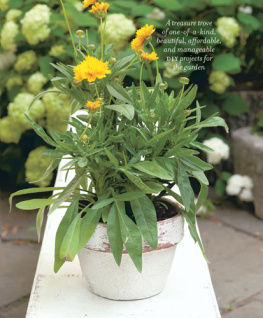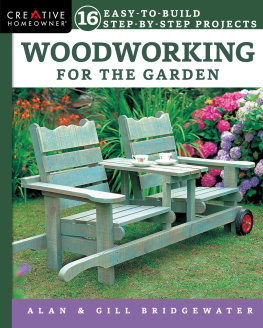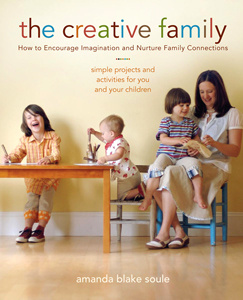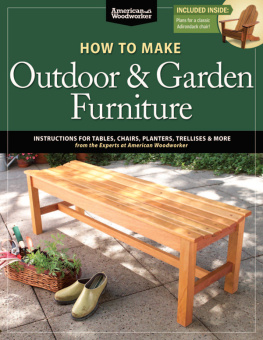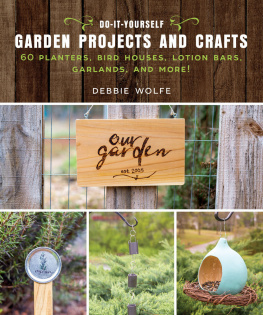HANDMADE FOR THE GARDEN
ingenious ways to enhance your outdoor space with DIY tools, pots, supports, embellishments & more
SUSAN GUAGLIUMI
PHOTOGRAPHS by John Gruen
PHOTOSTYLING by Raina Kattelson
ILLUSTRATIONS by Sun Young Park
STC CRAFT | A MELANIE FALICK BOOK
NEW YORK
For Jordan, the sun, the moon, and most of the stars in my sky
Published in 2014 by Stewart, Tabori & Chang
An imprint of ABRAMS
Text copyright 2014 Susan Guagliumi
Photography copyright 2014 John Gruen
Illustrations copyright 2014 Sun Young Park
All rights reserved. No portion of this book may be reproduced, stored in a retrieval system, or transmitted in any form or by any means, mechanical, electronic, photocopying, recording, or otherwise, without written permission from the publisher.
Library of Congress Control Number: 2013945656
ISBN: 978-1-61769-097-6
Editor: Melanie Falick
Designer: Sarah Gifford
Production Manager: Tina Cameron
Stewart, Tabori & Chang books are available at special discounts when purchased in quantity for premiums and promotions as well as fundraising or educational use. Special editions can also be created to specification. For details, contact specialsales@abramsbooks.com or the address below.

115 West 18th Street
New York, NY 10011
www.abramsbooks.com
CHAPTER 1
EARLY SEASON GARDENING
CHAPTER 2
POTTING
CHAPTER 3
MOSAICS
CHAPTER 4
CEMENT & HYPERTUFA
CHAPTER 5
STANDING TALL
SINGLE SUPPORTS, TRIPODS & TUTEURS
CHAPTER 6
RUSTIC TRELLISES,
FENCES, ARBORS & BOX SUPPORTS
CHAPTER 7
OFF-SEASON
PROJECTS & PLANNING

Willow sticks, woven right in the garden, support climbing nasturtiums.
INTRODUCTION
I love to craft and I love to garden. In fact, I often wish that the days could be longer or that I could manage with less sleep or spend less time on day-to-day responsibilities so that I could spend more time doing both.
I attended summer camp from the time I was five years old through college, when I worked as a counselor. There I made my first baskets, learned to pound copper discs into bowls, spatter-paint leaf designs onto stationery, lash poles, and build fires. When I began to explore more sophisticated crafts as an adult, I was amazed at how many of those early experiences had stayed with me and how familiar the materials and techniques were after so many years.
One of the reasons I spent so much time at camp (as did my two brothers) was that my mother was raising us alone. She worked long hours and saved all year so that the three of us could spend eight weeks at camp. We would grow and mature in so many new waysand she would get a break from the stress of everyday parenting.
My mother was incredibly smart and capable and she believed that I could do just about anything to which I set my mind. Between Mom and those summers at camp, I developed a strong sense of self that has allowed me to solve problems, see the world through a creative lens, and approach most new experiences with a positive, can-do attitude.
After studying special education at college, I married Arthur (an artist and university professor) and taught for a few years. When we went looking to buy our first home in 1970, we wanted an old one and found a gem that was built in 1847. We both got a workout using all our skillsand developing new onesas we restored, repaired, and improved that little place. What I didnt see coming was the amount of work it would also take to restore and care for the surrounding grounds. There were some plantings in place, but nothing had been pruned or cared for in years.
Antique houses are funny when it comes to landscaping. Too casual an approach and the place just looks like an old house in need of help. Too formal and it looks pretentious. I wanted an organic, gracious feeling, a sense that the landscaping had been in place since 1847. Im not sure that I succeeded back then to the extent that I might today, but I loved those first few beds that I rescued and tended, as I learned to tell an iris from a peony and chickweed from both. I cut my pruning teeth on a huge clump of lilacs that was more dead wood than living and found all kinds of surprises when I raked away debris.
We probably would have stayed in that house for many years, but in the late 1980s the state of Connecticut took the house under eminent domain to widen the road and we went looking for another old house that needed our love. The second house (built in 1832) was larger and a bit more elegant than the first one and, although some work had been done, we dove into a huge restoration project for the second time. Ditto for the landscaping.
While I had done all I could do to tend the gardens in the first house while I was also raising a small, rambunctious boy and teaching weaving classes locally, the scale of the second house provided many more challenges. And so it was there that I began to expand my interest in crafts to the gardens. I built decorative trellises to support old roses and made sturdy, practical supports for the vegetable garden. After a trip to Mexico, where we saw some fabulous pottery, I began cutting terra-cotta pots in half and adhering them to larger mother pots.
As craft became a larger and larger part of my gardening routine, I realized that the garden centers often didnt have what I wanted or needed or, if they did, it was prohibitively priced. Unique flowerpots, baskets, and plant markers were always priced higher than I could afford so I began making my own. I started keeping detailed notes and decided then that one day I would like to share my ideas and innovations in a book.
In 2004 we decided to build a smaller, new house. Part of the reason was our desire to have more time to spend on artwork, hobbies, and interests beyond just maintaining an old house (think money pit). True enough, new houses are so much easier to live in once you get used to things being level and working most of the time. But what I didnt see comingagainwas how much work and time it would take to establish the landscaping from bare dirt and lots of red rock.
While I initially missed the ambiance and abundance of my established gardens, I loved starting from scratch. My new garden called for different solutions and treatments than the century-old one I was used to tending, and I found a refreshing sense of freedom in planning and planting a garden that was truly, totally mine. All the red rock found its way into stone walls that became the bones for beds terraced on the hillside, which in turn provided me with the initial structure of my garden plan. I forged ahead with my goal of creating a beautiful garden in a space that only months before had been overgrown woodland.
), I had tried dozens of other, less successful and considerably more involved methods.
).
).
Handmade for the Garden is a culmination of my last ten years of workand playin my garden. The project instructions are written in the most straightforward way I could imagine. Ive chosen simple, low-tech methods and employed more than a few shortcuts to create beautiful and functional projects that most people should be able to complete with relative ease, reasonable expense, and minimal frustration. When possible, I recommend that you repurpose and recycle everyday objects just as I do.
.
). But I have to admit that I derive nearly as much pleasure from seeing the bones of the garden landscape in winter. This is when the gardens structure and plan take center stage, rather than the flowers and vines, when I can really see what I have done and get an inside look at what the garden still needs.
Next page
